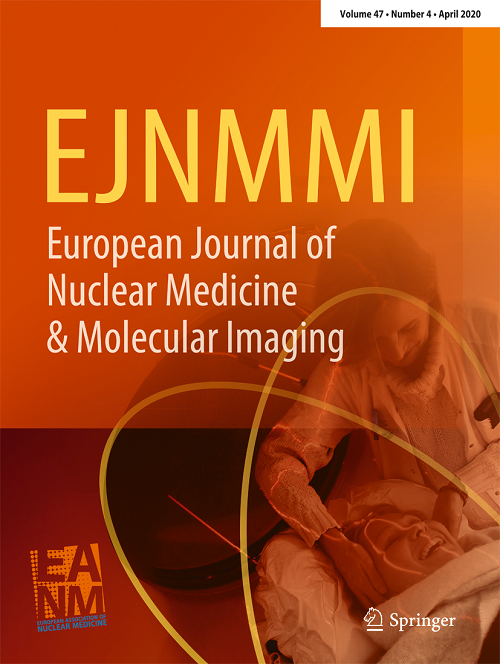Comparisons of treatment performance and therapy sequences in neuroendocrine neoplasms using progression-free survival ratios.
IF 8.6
1区 医学
Q1 RADIOLOGY, NUCLEAR MEDICINE & MEDICAL IMAGING
European Journal of Nuclear Medicine and Molecular Imaging
Pub Date : 2025-06-21
DOI:10.1007/s00259-025-07411-y
引用次数: 0
Abstract
INTRODUCTION Optimal sequencing of therapies is an important unresolved issue in metastatic neuroendocrine neoplasms (NEN). Progression-free survival (PFS) ratios constitute a potential method for intra-patient treatment comparisons and were used in this analysis to assess the relative treatment benefit of established therapies. METHODS This retrospective study included NEN patients of the Medical University of Vienna (treated in 2010-2024) who had metastatic disease and had received ≥ 2 palliative systemic therapies. The primary objective was the calculation of PFS ratios for therapy sequences, with the PFS ratio defined as the proportion of PFS2 (subsequent treatment) and PFS1 (prior treatment). RESULTS Of the 177 patients included, 104 had neuroendocrine tumors (NET) G1/G2, 16 NET G3, 28 lung/thymic carcinoids, and 29 a neuroendocrine carcinoma (NEC). In terms of treatment sequence, SSA was the most common first-line treatment in NET G1/G2 and thoracic carcinoids (n = 84), frequently followed by PRRT (n = 60), everolimus (n = 13), and treatments grouped as 'other' (n = 9). After platinum/etoposide in NEC (n = 26), FOLFOX/FOLFIRI (n = 13), CAPTEM (n = 3), and 'other' therapies (n = 9) were second-line therapies. The median PFS ratio for PRRT after first-line SSA was 1.86, for everolimus 0.99, and for 'other' treatments 0.59 (p = 0.004). Following platinum/etoposide, FOLFOX/FOLFIRI had a median PFS ratio of 0.46. In subgroup analyses according to primary localization, everolimus led to disproportionately long PFS intervals following SSA/PRRT in lung/thymic carcinoids, whereas therapies after PRRT exhibited relatively low PFS ratios in enteropancreatic NET. CONCLUSIONS PFS ratios accommodate the heterogeneity of NEN and can provide insights regarding treatment performance and treatment sequencing.使用无进展生存率比较神经内分泌肿瘤的治疗效果和治疗顺序。
治疗的最佳排序是转移性神经内分泌肿瘤(NEN)一个重要的未解决的问题。无进展生存期(PFS)比率构成了患者内部治疗比较的潜在方法,并在本分析中用于评估既定疗法的相对治疗益处。方法本回顾性研究纳入了2010-2024年在维也纳医科大学(Medical University of Vienna)接受过≥2种姑息性全身治疗的转移性NEN患者。主要目的是计算治疗序列的PFS比率,其中PFS比率定义为PFS2(后续治疗)和PFS1(先前治疗)的比例。结果177例患者中,神经内分泌肿瘤(NET) G1/G2 104例,NET G3 16例,肺/胸腺类癌28例,神经内分泌癌(NEC) 29例。就治疗顺序而言,SSA是NET G1/G2和胸部类癌中最常见的一线治疗(n = 84),其次是PRRT (n = 60),依维莫司(n = 13)和其他治疗组(n = 9)。铂/依托泊苷治疗NEC (n = 26)后,FOLFOX/FOLFIRI (n = 13)、CAPTEM (n = 3)和“其他”治疗(n = 9)为二线治疗。一线SSA后PRRT的中位PFS比为1.86,依维莫司为0.99,其他治疗为0.59 (p = 0.004)。继铂/依托泊苷后,FOLFOX/FOLFIRI的中位PFS比率为0.46。在亚组分析中,根据最初的定位,依维莫司导致SSA/PRRT后肺/胸腺类癌的PFS间隔过长,而PRRT后的治疗在肠胰腺NET中显示出相对较低的PFS比率。结论spfs比值反映了NEN的异质性,可以为治疗效果和治疗顺序提供参考。
本文章由计算机程序翻译,如有差异,请以英文原文为准。
求助全文
约1分钟内获得全文
求助全文
来源期刊
CiteScore
15.60
自引率
9.90%
发文量
392
审稿时长
3 months
期刊介绍:
The European Journal of Nuclear Medicine and Molecular Imaging serves as a platform for the exchange of clinical and scientific information within nuclear medicine and related professions. It welcomes international submissions from professionals involved in the functional, metabolic, and molecular investigation of diseases. The journal's coverage spans physics, dosimetry, radiation biology, radiochemistry, and pharmacy, providing high-quality peer review by experts in the field. Known for highly cited and downloaded articles, it ensures global visibility for research work and is part of the EJNMMI journal family.

 求助内容:
求助内容: 应助结果提醒方式:
应助结果提醒方式:


